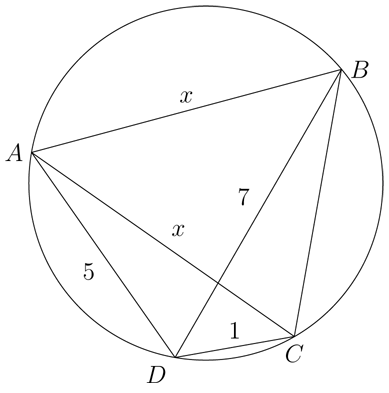Suppose that the distances DC, DA, DB are respectively 1, 5, 7, in some unknown units. Then AC and AB (which are known to be 500 in standard units) will be equal to $x$, say, in the unknown units.
The circle is the circumcircle of the triangles ABD and ACD. The circumradius of a triangle is always equal to one half of a side of the triangle divided by the sine of the opposite angle. Thus in the triangle ABD, $\sin(\angle BAD) = \dfrac7{2R}$; and in the triangle ACD, $\sin(\angle ADC) = \dfrac x{2R}.$
The cosine rule in triangle ABD gives $\cos(\angle BAD) = \dfrac{x^2-24}{10x}$; and in triangle ACD it gives $\cos(\angle ADC) = \dfrac{26-x^2}{10}.$
Now use $\sin^2 + \cos^2 = 1$ for those two angles to get the equations $$\frac{49}{4R^2} + \frac{(x^2-24)^2}{100x^2} = 1, \qquad \frac{x^2}{4R^2} + \frac{(26-x^2)^2}{100} = 1.$$ Multiply out the fractions to get $$25*49x^2 + R^2(x^2-24)^2 = 100R^2x^2, \qquad 25x^2 + R^2(26-x^2)^2 = 100R^2.$$ Subtract the second equation from the first to get $-96R^2x^2 + 25*48x^2 = 0$, which leads to $R = 5/\sqrt2$ (in the unknown units). Substitute that value for $R$ into one of the two equations, which then reduces to $(x^2-25)^2 = 0$. Thus $x=5$. But we know that $x=500$ in standard units, so we need to multiply by 100, giving $\boxed{R= 250\sqrt2}$ as the solution.


